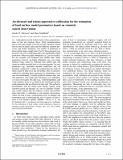An alternate and robust approach to calibration for the estimation of land surface model parameters based on remotely sensed observations
Author(s)
Salvucci, Guido D.; Entekhabi, Dara
DownloadEntekhabi_An alternate.pdf (338.3Kb)
PUBLISHER_POLICY
Publisher Policy
Article is made available in accordance with the publisher's policy and may be subject to US copyright law. Please refer to the publisher's site for terms of use.
Terms of use
Metadata
Show full item recordAbstract
[1] Atmospheric models include land surface parameterizations of heat and moisture fluxes. Most parameterizations derive from early models of layered soil and vegetation canopy that account for liquid, vapor and heat diffusion, radiation processes, and surface turbulence. The number of parameters in these models ranges roughly from 10 to 50. Some parameters are known to vary over a small range and/or not significantly impact predictions. Others are highly influential (e.g., Leaf Area Index), but are currently well estimated from satellite data. Many parameters, however, are highly influential, vary over a large dynamic range, cannot be estimated from satellite data, and cannot be readily upscaled from in-situ measurements. For such parameters (e.g., maximum stomatal conductance and soil hydraulic conductivity), values are assigned based on look-up tables sorted by land cover and soil texture. Here we present a method for estimating these parameters by minimizing a measure of nonstationarity of model-predicted moisture state variable tendencies. This method has advantages over calibration: 1) it does not require flux data (e.g., evapotranspiration); and 2) the tendency terms are evaluated at the model grid and thus yield parameters that are effective for that scale. The method is demonstrated with the Noah Land Surface Model, using remotely-sensed soil moisture, at a site in California. Preliminary results indicate that the method is robust and performs better than both: 1) calibration to soil moisture observations, which can lead to large, compensating errors in drainage and evaporation; and 2) minimizing the sum of squares of innovations of soil moisture updates.
Date issued
2011-08Department
Massachusetts Institute of Technology. Department of Civil and Environmental EngineeringJournal
Geophysical Research Letters
Publisher
American Geophysical Union (AGU)
Citation
Salvucci, Guido D., and Dara Entekhabi. “An Alternate and Robust Approach to Calibration for the Estimation of Land Surface Model Parameters Based on Remotely Sensed Observations.” Geophysical Research Letters 38.16 (2011). Copyright 2011 by the American Geophysical Union.
Version: Final published version
ISSN
0094-8276